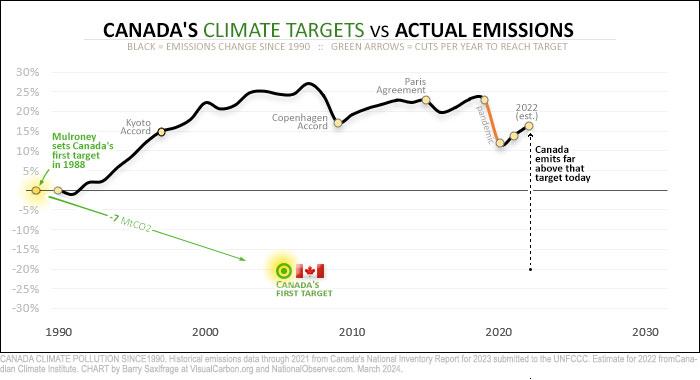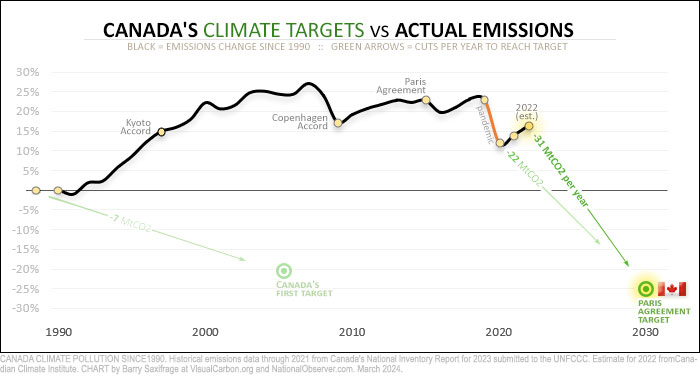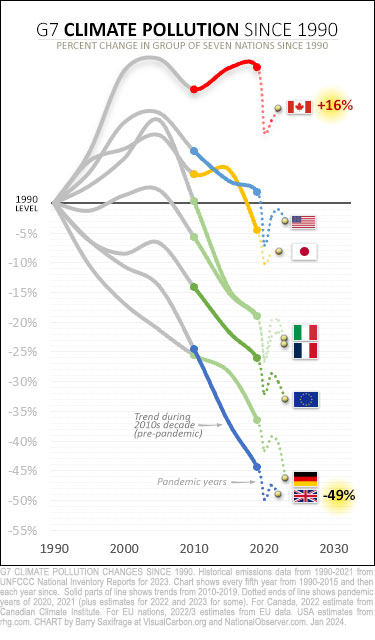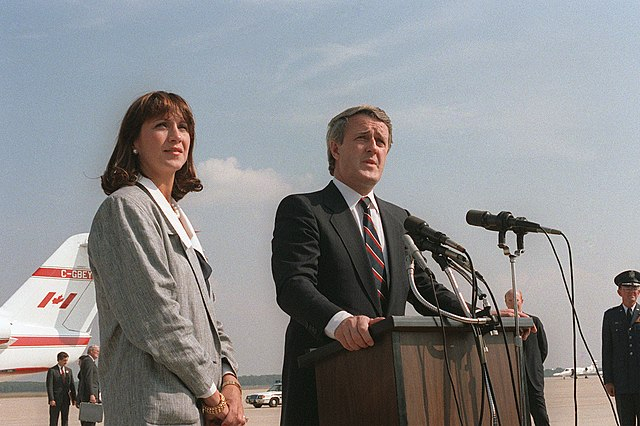Support strong Canadian climate journalism for 2025
Way back in 1988, then Prime Minister Brian Mulroney and his Progressive Conservative government set Canada's first climate target. The goal was to reduce Canada’s oversized climate pollution 20 per cent by 2005.
Unfortunately for all of us, Mulroney never got to see Canada reduce our emissions that much.
Or at all.
Instead, the opposite happened. Canadian emissions went up and stayed there.
Here’s a quick look at how it started in Canada — and how it’s going.
Canada’s first climate target
The chart below shows Mulroney’s first climate target as a green bull's-eye in 2005. Compare that to the bold black line showing Canada’s actual climate pollution since 1990.

There are two things worth noting about this target.
The first is the pace of emissions cuts that would have been required to meet it. If we’d started in 1988 when Mulroney set the target, we’d have needed to cut seven million tonnes of CO2 (-7 MtCO2) each year. That’s shown by the long green arrow on the chart. As we will see below, that’s a leisurely stroll compared to what we face now.
The second thing to note is how far above this target Canada’s emissions remain today. This huge gap is shown by the dashed vertical line on the right.
Canada’s upcoming climate target
Fast-forward 36 years and five prime ministers … to today.
Canada’s next climate target is our 2030 Paris Agreement target. I’ve added it to the chart below as the green bull's-eye in the lower right. It works out to 25 per cent below 1990 levels. That’s nearly the same reduction goal as our first target. We’ve just been kicking the can down the road for decades.

But there’s one big difference now. We squandered all those decades we had to act. Now, with few years remaining, our path has become dauntingly steep. And each year we fail to cut emissions makes it worse.
For example, at the start of 2020, we needed to cut 22 MtCO2 each year to meet our Paris Agreement target. That’s shown by the faded green arrow on the chart.
But instead of cutting emissions, we increased them for the next two years. As a result, our task grew exponentially harder. By the start of 2023, we needed to cut 31 MtCO2 each year. That’s shown by the dark green arrow. That’s four times faster than what Mulroney proposed back in 1988. And it is double the largest emissions cut we’ve made in any normal economic year in the past.
That’s the brutal math of climate foot-dragging.
Kicking the can down the road doesn’t make the problem go away. Instead, it feeds the angry climate beast while also endangering Canada’s economic future.
Exposed high up the carbon cliff

We’ve left ourselves extremely exposed, far higher up the carbon cliff than most of our peer nations.
For example, all our peer nations in the Group of Seven (G7) advanced economies have been climbing down the carbon cliff for more than a decade now. All are below their 1990 levels — even the Americans.
And some of our peers, like the British and Germans, are halfway down already.
Canada is alone in the group, stuck far up the cliff.
And now the long-predicted storm clouds are gathering around us all, making the descent increasingly difficult.
We obviously should have started 36 years ago when Prime Minister Mulroney first showed us the way down. That would have been a lot easier. But now is the best option we've got left. And the faster we start climbing down in earnest, the more likely we will make it down safely.




Comments
Canada has only become a global embarrassment, year after year.